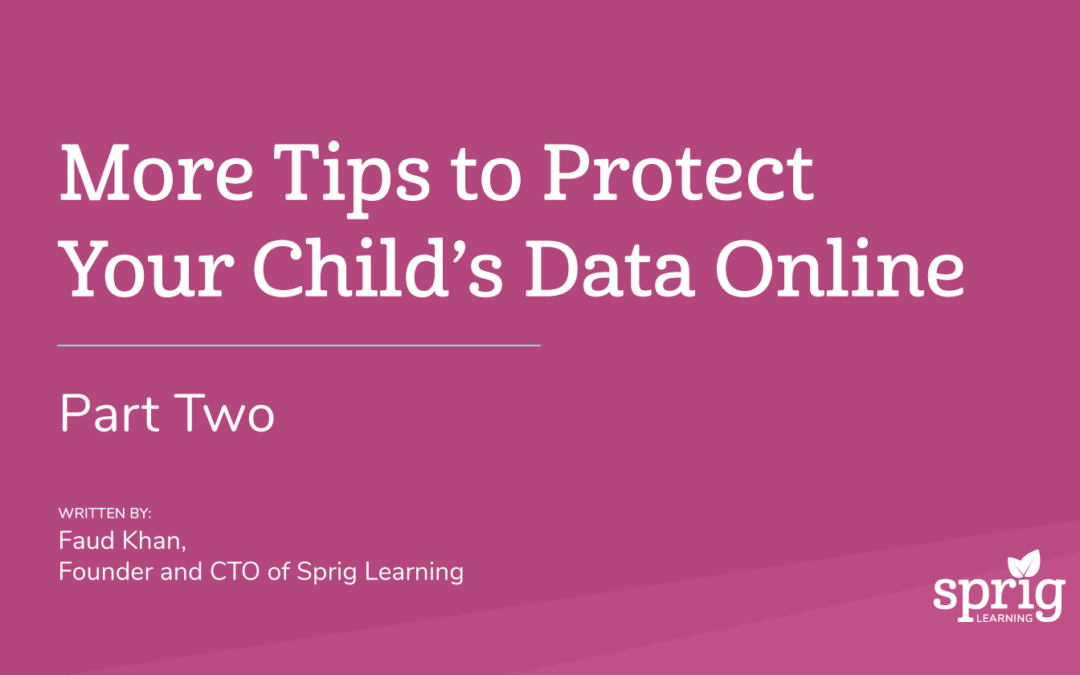As a follow-up to Part One – Children on Computers, we now shift the focus to securing data on mobile technology. While the evolution of mobile and wireless technologies have contributed positively to lives over the past 10+ years, many people continue to debate the benefits and highlight the negative impact of being ‘hyper’ connected.
Today, we’re providing you with some important tips to implement across all mobile devices and EdTech platforms. This will help ensure you and your child are protected online:
- Update software – For iOS, it’s easy to set up automatic updates. For Android, updates can be a bit more complicated to set up, because some are dependent on the carrier. Many carriers prefer to sell phones and don’t do much to educate you about updates. In fact, some Android phones, after a period of about three years, will lose the ability to process updates. Do your research when choosing phones, and remember to ask your service provider to explain the life cycle of the phones you consider and ask if they include product support;
- Encrypt your data – For iOS, data storage is encrypted by default and is unlocked when you enter a passcode. For Android, you must enable this feature yourself. We also recommend that, if you use SD or other memory cards, to ensure these devices are encrypted in the event they are ever lost. Learn more about data encryption.
- Choose a strong unlock code/biometric – We hold a lot of confidential information/ data on our devices. It is essential that we create as many barriers to access this information as possible. We always recommend 2-factor authentication (2FA) whenever possible. For example, use one code to gain access to the physical device and then use a second code (or biometric) to approve/allow things like purchasing or access to settings. The reason is simple – if your phone is lost, someone could possibly gain access through one code, but typically not two. Remember: always create a secure password and do not use the same one across devices or accounts (bank code, home security code, etc.) This would allow someone who knows one passcode to gain access to all of your critical assets;
- Enable location detection – We all get busy, it’s so easy to misplace, drop, or lose your device. Having the location turned on allows you to easily find or trace the location of your device. Get more info about location detection for iOS devices, and for Android devices;
- Stay off public Wifi networks – Use public Wifi networks sparingly. Consider that public Wifi collects your data and may sell it to various marketing firms. If you are accessing email, banking, or social accounts, there’s a possibility they could be compromised. Learn more about the dangers of using public Wifi and if you must use these networks, please install and configure a VPN application (such as IVPN) to ensure your communications and identity are protected;
- Anti-virus app – It may seem a bit strange, but viruses and malware can infect a mobile device. Anti-virus apps will alert you when you stumble upon potentially suspicious websites, files, or transactions on your phone or tablet. Keep in mind, your phone is always on and connected to a network. Even while you sleep, someone could be attempting to access your device. It’s easy to forget that your phone or tablet is just another IP address on a network. We recommend looking into Avast and Kaspersky;
- Backup your device – This one is really important and should be done at least once a week. There are countless stories of parents losing priceless images or videos of their kids when a phone is dropped or damaged, and there are cases when it cannot be repaired/files can’t be recovered. Don’t let this happen to you! Back everything up to a cloud service of your choice – and do it regularly. Learn about backing up on iOS and on Android;
- Don’t jailbreak/root your phone – When you jailbreak your phone, it essentially removes all security controls on your device, including setting some default access passwords. What does this mean? Well, your phone is able to be scanned on a public network and someone could easily access your device using these logins without you even being aware that it’s happening. This can lead to data loss and possibly a full compromise of your device; your entries could be recorded and forwarded to someone else. If you use mobile banking, this could lead to your account balances being transferred to another account or in some extreme cases – identify theft.
This may sound pretty scary, and in some cases, it truly can be. Just remember to be vigilant and ensure you are taking all measures to keep your data and your child’s data safe.
With these tips in play for children using mobile devices, you’re doing your part to keep your data safe and secure. Stay tuned in the coming weeks for Part Three, when we will discuss security tips for families using ChromeBooks.
All links provided within this after are meant to provide you with the information you need to do your part to keep your mobile devices secure. Note: We do not endorse nor receive any monetary rewards for the software/programs we are recommending. We use them personally, so we have experience in using them and have found them all to provide the additional layers of protection for ourselves and our staff members.
About the Author


